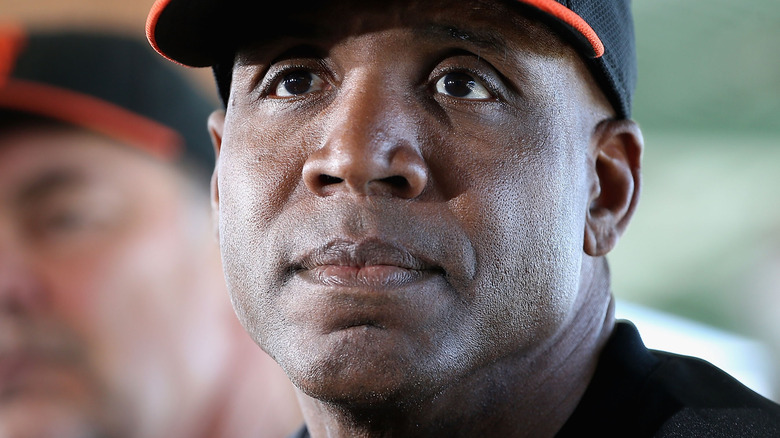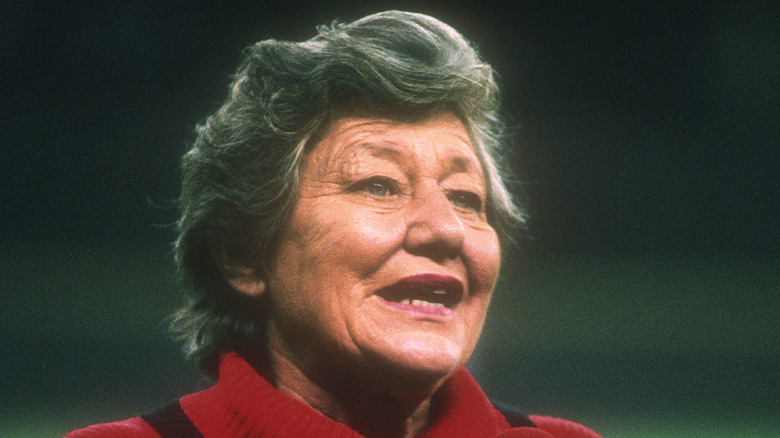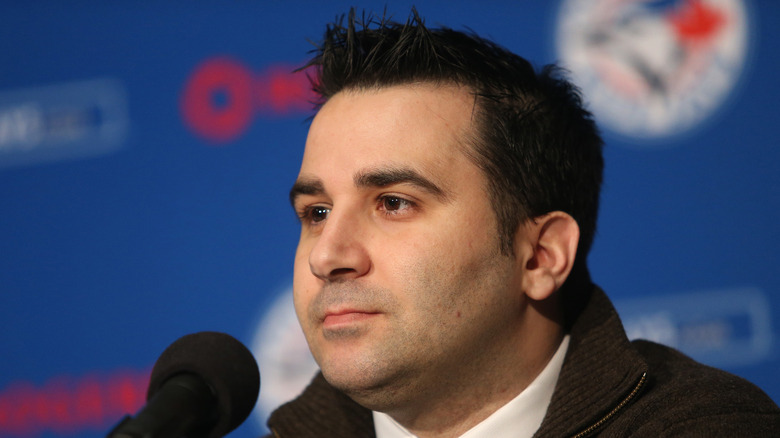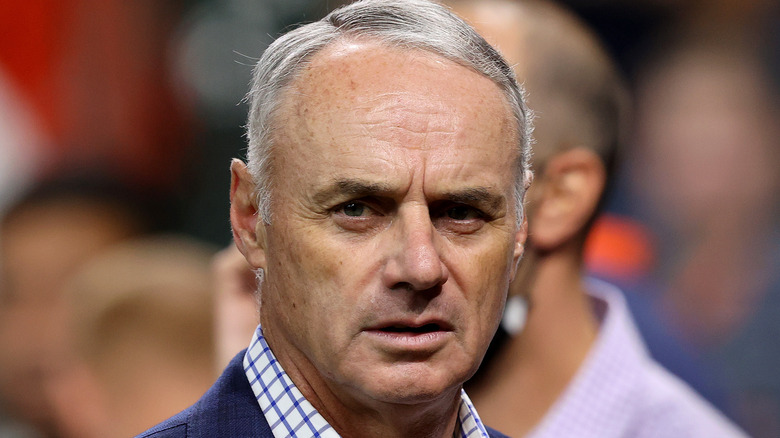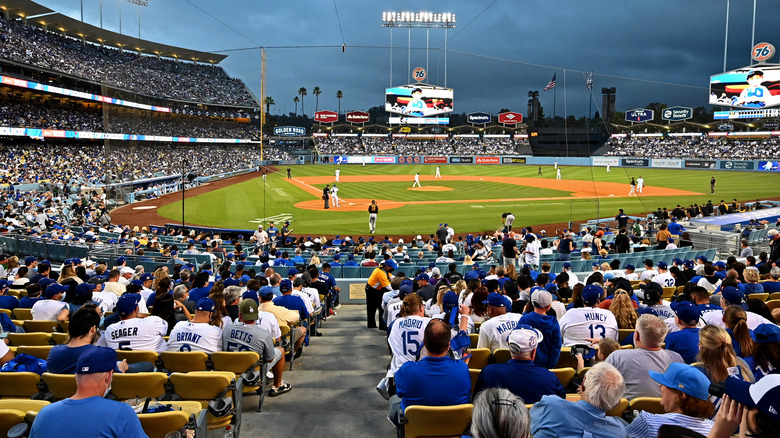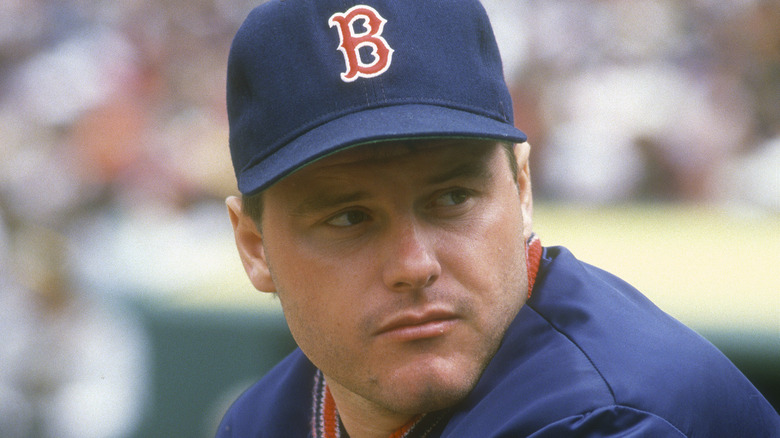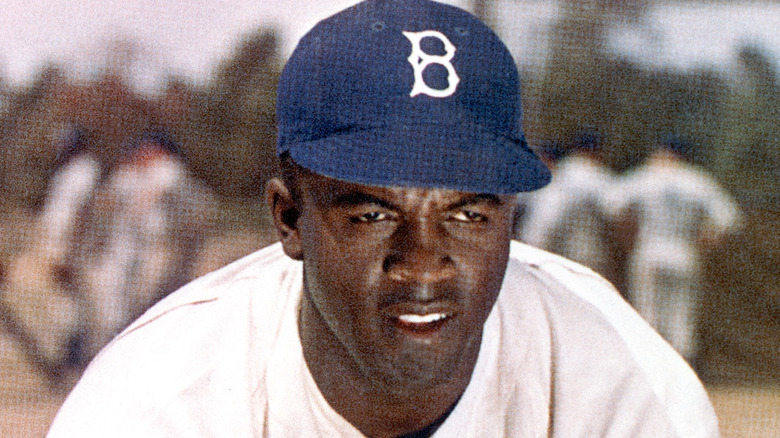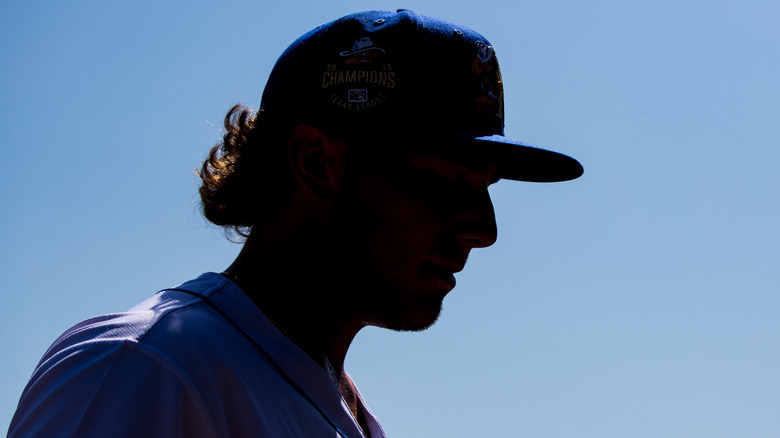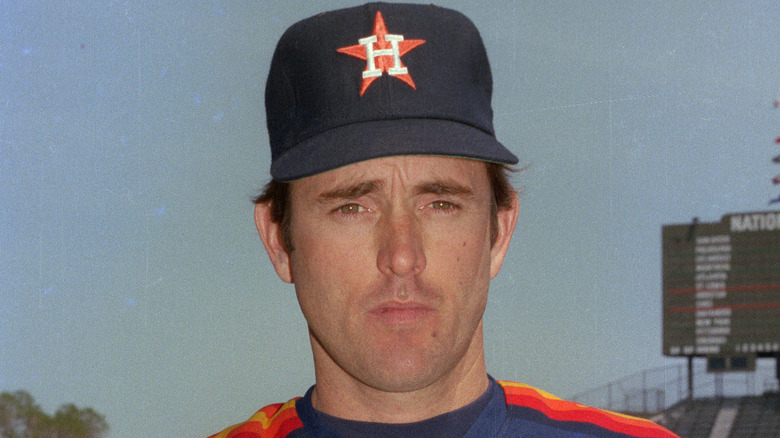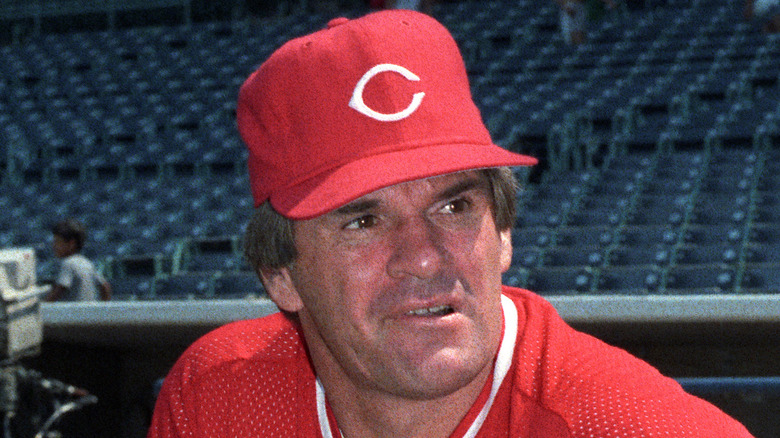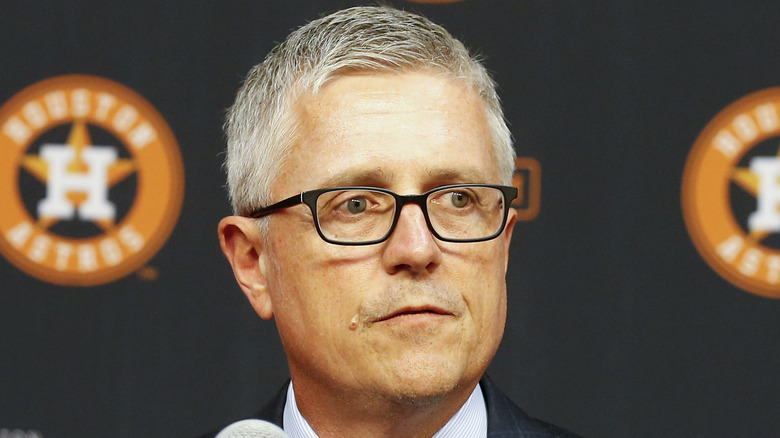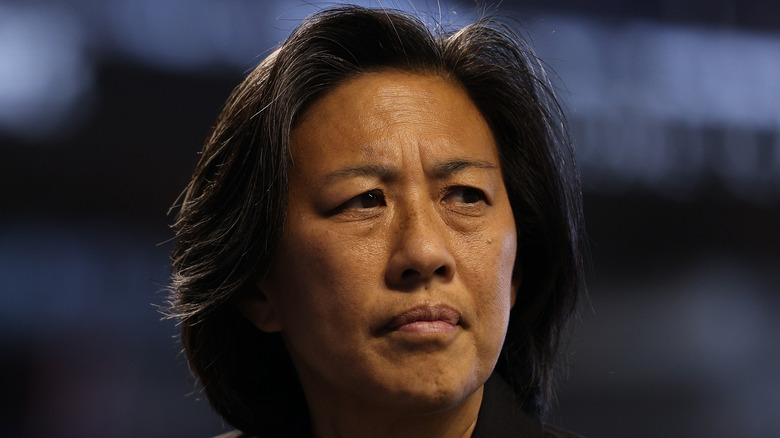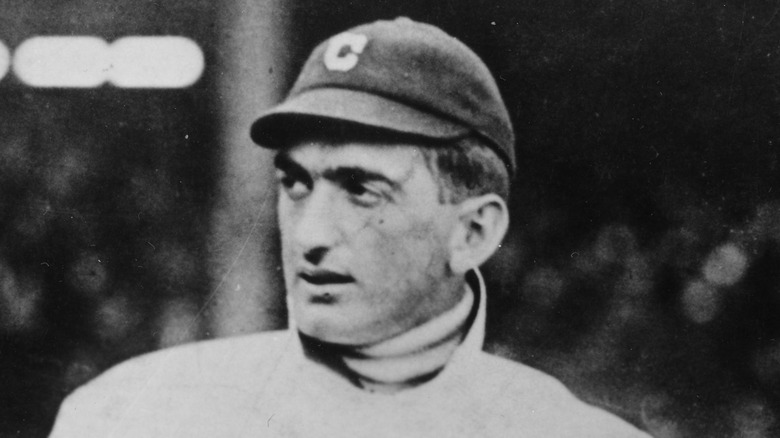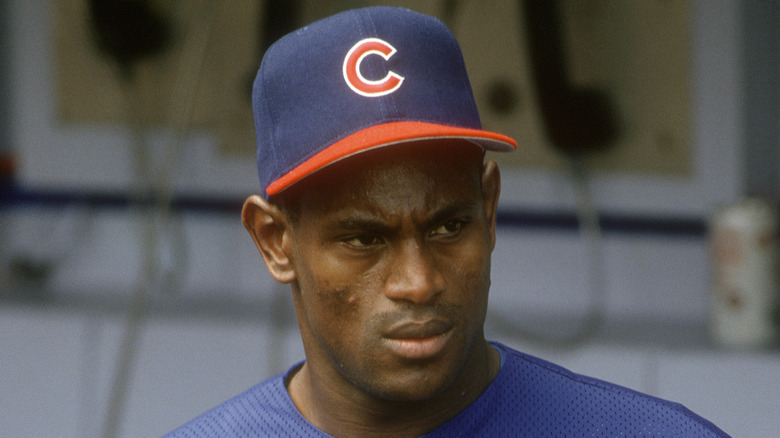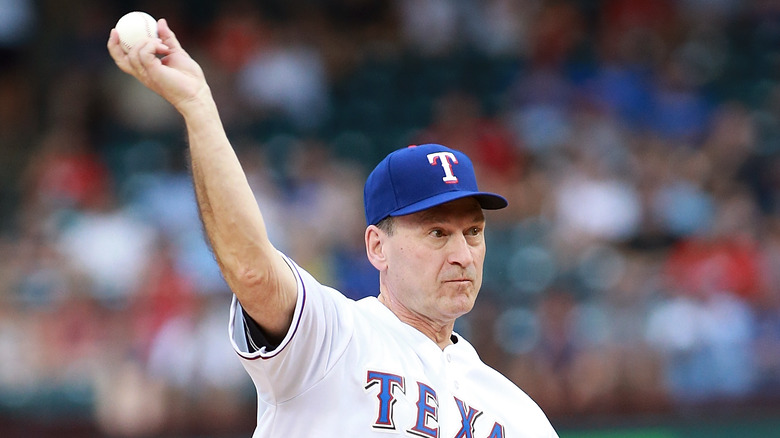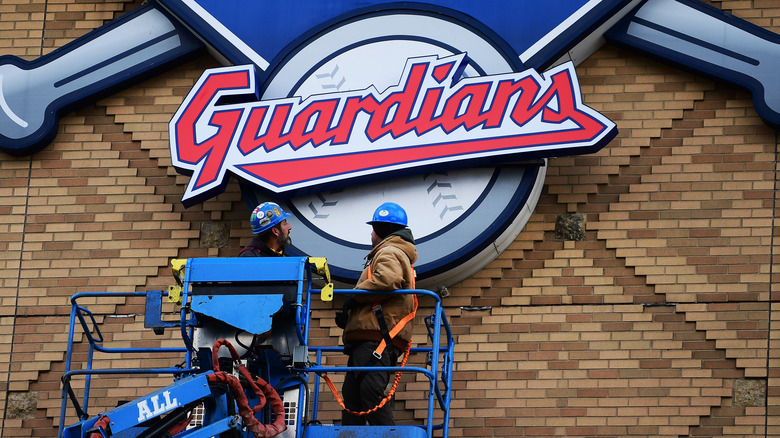MLB's Darkest Secrets
America's pastime, baseball, was the first professional sport in the country. The iconic game has been around since the 18th century and started as an offshoot of cricket. In 1845, "a group of New York City men founded the New York Knickerbocker Baseball Club. One of them — volunteer firefighter and bank clerk Alexander Joy Cartwright — would codify a new set of rules that would form the basis for modern baseball, calling for a diamond-shaped infield, foul lines and the three-strike rule," History recapped. Not only did baseball become wildly popular across the country, but playing the game also became a respite for soldiers during the American Civil War.
The sport outlasted even more conflicts, like when future members of the National Baseball Hall of Fame served in the military during World War I. By World War II, over 500 professional players served for their country. In fact, "President Franklin Delano Roosevelt issued what is now known as the 'Green Light Letter' to encourage play to continue. He deemed the game a necessary morale booster during the difficult times."
Even with all the feel-good stories and wholesome family fun at ballparks, baseball also has a darker side. Similar to the negative aspects of the NFL, Major League Baseball has several moments it wishes could be erased. From drug use in the league to shady owners and cheating, fans of baseball are all too familiar with scandals.
Step up to the plate and get ready to learn MLB's darkest secrets.
The league's worst owner
Former Cincinnati Reds owner Marge Schott could be the shadiest owner in sports ever. In 1993, a former employee for the Reds claimed he was fired because he objected to Schott using extremely racist language. She denied the charges but also admitted that she "very seldom" used racist terms and didn't consider herself offensive, the Los Angeles Times reported. Schott also confessed that she kept a swastika at her house. And in a 1996 ESPN interview, she stated that Adolf Hitler "was good at the beginning, but he just went too far."
The terminated employee filed a lawsuit against Schott, who was slapped with a fine and banned from her box seat for a year in 1993 as a result. For her ESPN comments, she "was forced to give up day-to-day control of the Reds until 1998," per NPR. It wasn't until 1999, after being the Reds' owner since 1984, that Schott was forced out of the organization.
Marge Schott Stadium was also the name of the University of Cincinnati's baseball stadium. In 2020, the school decided to remove her name from the field, in addition to a library archive. "Marge Schott's record of racism and bigotry stands at stark odds with our university's core commitment to dignity, equity and inclusion," the school's president said in a statement, per AP. The move followed the decision by Saint Ursula Academy in Cincinnati to remove Schott's name from one of its academic buildings and that of her dog from the school's athletic facility.
Owners have conspired against players
In their original labor contract with the Major League Baseball Players Association (MLBPA) in 1968, MLB owners were adamant "that collusion be against the rules. Their fear was that the players, in a pre-free-agency world, would work together in negotiations to raise their collective salaries," SB Nation summarized. Instead, collusion became a word associated in the opposite direction, with owners conspiring against the players.
Starting in the mid-80s, many MLB team owners began focusing on turning a profit — by limiting spending on free agents — instead of trying to win the World Series. "By 1990, three arbitration rulings established that they had colluded illicitly, and they ended up paying $434 million, including interest, to settle players' case against them. That sum would be the equivalent of about $800 million today," the Los Angeles Times reported.
Unfortunately, it looked like owners were once again up to no good decades after the ruling in 2018. "There are signs that the owners are colluding again to force down players' salaries and lock in their own profits," The Los Angeles Times wrote. The most obvious sign, according to the players association, was the huge amount of unsigned free agents while team revenues and profits were skyrocketing. In one example, Atlanta Braves general manager Alex Anthopoulos mentioned that he worked with 27 clubs to discuss players that may be available for free agency. As a result, the MLBPA announced via Twitter that it would investigate "the integrity of the entire free-agent system."
The league kept making big bucks as fans paid more
"Buy me some peanuts and Cracker Jack," goes the lyrics to "Take Me Out to the Ball Game," per Baseball Almanac. For fans who do just that while attending MLB games, all those peanuts turn into more than peanuts in the pockets of MLB owners. However, the league took a major hit financially as a result of the COVID-19 pandemic. MLB commissioner Rob Manfred reported that it had "$3 billion in operating losses for 2020 due to fans being unable to attend games and a 60-game shortened season," per Forbes. This negative trend didn't last long, as some teams quickly bounced back financially after the shorter season. For example, the Atlanta Braves' revenue increased from $110 million in 2020 to an estimated $234 million the following year.
In fact, all MLB teams seemed to be doing just fine in the midst of the pandemic. The average franchise value reached an all-time high in 2021 at an estimated $1.9 billion, Forbes reported. But some of the league's biggest supporters didn't exactly benefit from its good fortune. According to Team Marketing Report, baseball fans had to pay an average of 4.5% more to attend MLB games in 2021 compared to the previous year. Some Oakland A's fans were appalled to learn that season ticket costs were rising to almost twice their 2020 prices, with one season-ticket holder telling The San Francisco Chronicle, "It just feels like they're sending the message to us — you are not important."
Baseball fans are dwindling
An eight-year contract between MLB and national TV networks ended in 2021. Even though MLB stood to earn significant revenue for its next TV contract from 2022 to 2028, there was a concerning decision from ESPN. The network, owned by The Walt Disney Company, "did not take as many games in the new deal as it did in the current one," Forbes reported.
This may be in part because the number of baseball fans, and sports fans in general, appear to be decreasing. "It's critical to reach a younger portion of the fan base," the league's chief operations and strategy officer Chris Marinak told The New York Times. "They have the longer span of fandom. We need to do a better job of communicating to Gen Z what it means to be a fan," he added. On the field, MLB has used the minor leagues to test out rule changes to pick up the pace of the notoriously slow game. This has included introducing "pitch clocks and limits on defensive shifts to make games shorter and more exciting."
To cater to the next generation of fans, MLB also "recruited influencers to produce TikTok content for the World Series." After a competition to look for creators that focused on baseball-specific content, MLB announced the inaugural list of 11 influencers in its Creator Class. Each creator earned the opportunity to attend games and other sponsored events to highlight "the players and game on and off-the-field through music, fashion, art and more" in short videos.
Players used illegal drugs
The reported use of steroids and other performance-enhancing drugs in professional baseball became so serious that the United States Government intervened to investigate. In 2007, a shocking summary referred to as the "Mitchell Report" rocked the baseball world. "Former Senator George J. Mitchell released a blistering report Thursday that tied 89 Major League Baseball players to the use of illegal, performance-enhancing drugs," The New York Times reported. The senator summarized what he referred to as "baseball's steroids era," which began in 1988. According to testimonies from both players and people involved in the sport, many of the biggest names in the league, including Barry Bonds and Roger Clemens, allegedly used illegal steroids for years.
Clemens repudiated the claims and went as far as to double down on his denial by appearing in an awkward "60 Minutes" interview. Per The New York Times, "Neither Bonds nor Clemens was charged with using or possessing P.E.D.s. They were charged with making false statements and later cleared."
In 2021, Bonds and Clemens still faced questions about their legacies because of the steroid allegations and were once again left out of the Baseball Hall of Fame. "That group has lingered on the ballot for nine years," The New York Times reported. There's still a chance that they'll eventually be enshrined among the other all-time greats thanks to the Baseball Hall of Fame's Today's Game Committee, but CBS Sports writer Matt Snyder believes "it might not even happen while they are alive."
A history of segregation
Though the nation's pastime has long been a source of entertainment for fans of all ages, it has also revealed an ugly truth about inequality in the country. "For nearly 60 years baseball was a segregated sport as the American and National Leagues that formed Major League Baseball unofficially banned African-Americans from their ranks," per MLB.
Starting in the 1850s, African Americans in the South began to play the sport "despite the proliferation of Jim Crow laws," the National Baseball Hall of Fame recapped. Decades later, Bud Fowler – a 2022 Hall of Fame inductee — became "the first Black player in professional baseball." Sadly, Black players began to be banned from professional teams, so a number of them formed their own "barnstorming" teams and went "around the country to play anyone who would challenge them," per the NLBM. By 1920, the Negro National League was founded, and with the addition of other leagues, these became collectively known as The Negro Leagues.
One of the most famous Black players in baseball history is Jackie Robinson, who joined the Brooklyn Dodgers in 1947. It was a momentous occasion, but the superstar still had to deal with hatred. "Despite Robinson's stellar play, he endured a great amount of verbal abuse from fans," MLB recapped. On the field, "opposing players hurled verbal insults at Robinson but they also played rough and employed tactics that many saw as outside the bounds of acceptable play." Fortunately, Robinson endured all the animosity and paved the way for future progress.
Minor leaguers struggle
Before joining MLB, many players start in the minor leagues to grow their skills in preparation for moving up to the biggest stage in the sport. In fact, some MLB stars will even drop down to the minor leagues, called "being optioned," before being called back up to the majors. Not only is their time in the lower leagues less prestigious, but it can be a truly difficult experience.
Players often use side hustles to add to their $500-per-week salary, "barely making ends meet," ESPN reported. Some must move "from place to place and team to team, subsisting on junk food and sleeping on living-room air mattresses." Outside of their time playing on the baseball diamond in front of fans, many minor league players deal with "substance abuse, financial hardship, inadequate housing, lack of access to healthy food, anxiety and depression."
One former player in the Los Angeles Angels organization specifically called out the team's owner, Arturo Moreno, who was worth an estimated $3.6 billion as of 2022, per Forbes. "Arte Moreno wouldn't have his kids live like this," the minor league player told ESPN about his poor living conditions. Many other players feared speaking about their experiences for fear of damaging "the trajectory of their careers." Plus, losing everything can happen at a moment's notice. As a result of the COVID-19 pandemic, many minor league teams struggled financially. So, in 2020, hundreds of players were cut in anticipation of the minor league season being canceled, ESPN reported.
MLB's sticky situation
MLB pitchers have an amazing ability to hurl a ball towards home plate with lightning speed and wickedly deceptive spin. While this is definitely due to training and natural abilities, some players look for an additional edge with sticky substances like pine tar, spit, and mud. "Pitchers definitely cheat," a baseball analyst told The Washington Post. These foreign substances "alter the way in which the ball travels to the plate, allowing a pitcher to manipulate the ball in an unnatural way." According to MLB's rule book, any "foreign substance" is banned in addition to the practice of rubbing the ball with something like sandpaper to alter its flight.
Famous pitcher Nolan Ryan once talked about what he considered a gray area in cheating. He said in an interview on ESPN, "Using pine tar to help your curveball, stuff like that, those are things that are done in the game that are accepted as part of the game." While the pitcher didn't admit to cheating, Ryan explained that he was not opposed to using similar tactics.
After widespread reports of pitchers cheating, MLB decided to fight back by using some impressive technology. In 2021, the league told all its teams "that it will begin using its Statcast data to analyze increases in spin rate, specifically for pitchers suspected of doctoring baseballs," the New York Post reported. The league also hoped this would help create more action in the sport beyond just walks, strikeouts, and home runs.
The Pete Rose story
In a sport known for a dazzling amount of data and records, there are a few that may never be broken. For example, the "Hit King" Pete Rose has 15,890 career plate appearances and 4,256 hits in his time as an MLB player for 24 seasons. This means he stepped up to the plate an average of 662 times in a season.
While he will forever be remembered for his impressive on-field stats, Rose is much more remembered for his time as a manager of the Cincinnati Reds. He "accepted a lifetime ban in 1989 for gambling on the Reds when he was their manager," The New York Times recapped. Despite his Hall of Fame-worthy performances on the baseball diamond, sadly, the gambling scandal continued to haunt Rose for decades. As of 2021, Rose "remains permanently ineligible to work in Major League Baseball, and thus remains ineligible to be elected to the Hall of Fame." Rose applied to be reinstated into MLB in 2015, 2017, and 2020 but was denied by the league's commissioner, Rob Manfred, each time. So Rose's chances of ever being enshrined among other legendary players in the Hall of Fame don't look great.
Some believe that his punishment is far too severe for his actions. For instance, "no one has ever claimed that Rose's misconduct was intended to gain a competitive advantage over other teams or had the slightest effect on the outcomes of any games," per The New York Times.
A cheating scheme by the best team in baseball
The Houston Astros concluded their underdog story in MLB by going from one of the worst teams in the league in 2013 to winning the World Series in 2017. But three years later, the Astros became the embarrassment of MLB. In 2020, "a scathing report by Major League Baseball exposed the Astros as cheaters, trashing their reputation, ousting their leaders and igniting the sport's biggest scandal since the steroid revelations of the 2000s," The New York Times reported.
The Astros were caught stealing signs of their opposition. Specifically, managers and players were involved in "a brazen scheme to illegally use electronics to steal opposing catchers' signs and tip off their own batters to what pitch was coming," which took place in 2017 and 2018. As punishment, the four people involved, including the team's general manager at the time, Jeff Luhnow, lost their jobs in the league. Another career casualty was Carlos Beltrán's manager position with the New York Mets. He'd been a senior player with the Astros and was allegedly a mastermind of the scheme, per The Athletic.
Many felt the one-year suspensions for Luhnow and manager AJ Hinch and no punishment for the Astros players were too light of a reaction to a scandal that so clearly undermined the integrity of the game. "I think if you watch the players, watch their faces when they have to deal with this issue publicly, they have paid a price," MLB commissioner Rob Manfred told ESPN about his decision.
The treatment of women in the league
Behind the scenes in MLB, women have often been discriminated against. In 1977, Melissa Ludtke sued the league when she was a reporter for Sports Illustrated. At the time, clubhouses at Yankee Stadium denied her entry because of her gender. Decades later, sexual harassment allegations surfaced in the league. "I'm dismayed that after 42 years since the decision came down basically saying that women reporters should be treated equally to men, the attitudes don't seem to have evolved in the way you might have expected they would," Ludtke told The New York Times. As a result, MLB updated its harassment and discrimination policy.
Though slow at first, there has been some promising progress for women in the league. In 2020, the Miami Marlins named Kim Ng as its general manager, making her "the first female GM in the history of major North American men's pro team sports and the first East Asian American" to lead a MLB team, per Time. It was long overdue for Ng, who previously interviewed for several GM positions. In an amazing story, Ng received an award from Derek Jeter in 2000 when she was the assistant GM for the New York Yankees. Twenty years later, Jeter, who became the Marlins' chief executive and part owner, hired Ng to lead the franchise, per The New York Times. That same year, the San Francisco Giants hired Alyssa Nakken, making her MLB's "first full-time female coach" ever, The Washington Post reported.
The crooked past of MLB
In the early days of MLB, the league dealt with an embarrassing scandal in the biggest event of the season, the World Series. In the 1919 championship, "eight players from the Chicago White Sox conspired with professional gamblers to rig the outcome of the World Series, enabling the underdog Cincinnati Reds — and bettors in the know — to win," The New York Times recapped. At the time, the White Sox were the heavy favorites.
After losing several games of the best-of-nine series, some of the players apparently wanted their money. When they didn't receive the amounts promised by the gamblers, the team vowed to try and start winning games. This worked for two games but "backing out of a deal with gangsters proved difficult ... and several of the players later hinted at having received threats against their families," History reported. In game eight, the White Sox lost and gave the Reds its first World Series victory.
Speculation began that something seemed wrong about the entire series, and months after the last game, an article came out titled, "Is Big League Baseball Being Run for Gamblers, With Players in the Deal?" The owner of the White Sox denied the allegations, but the focus turned back on the team when a regular-season game the following year was proven to be rigged. Eight players were indicted for conspiracy and banned for life from the league. The players were then forever known as the Black Sox.
Players used modified bats
Corks are made for champagne but not baseball. Yet, some players have used the material inside their bats to get a little extra pop while swinging for the fences. For example, player Albert Belle of the Cleveland Indians was caught using an illegal bat in 1994. The opposing team, the Chicago White Sox, suspected Belle was cheating and asked umpires to inspect his bat. Even his own team knew that Belle was using a modified bat. "Jason Grimsley, Belle's teammate at the time, went to great lengths to heist the confiscated bat," to protect Belle, Fox Sports recapped. That is, Grimsley crawled through the ceiling to "steal the bat out of an umpire's dressing room," per SB Nation.
Years later, in 2003, famous Chicago Cubs player Sammy Sosa was ejected from a game for using a corked bat. His bat broke while swinging, and a video of the game shows the umpires collecting the broken pieces. Upon further inspection, the plate umpires concluded that there was indeed cork inside. In a post-game press conference, Sosa apologized "from the bottom of my heart," the Chicago Tribune recapped. According to the player, he mistakenly switched up his legal, game-ready bat with a corked bat that he used for "batting practice and for home run exhibitions to entertain his fans." Slammin' Sammy racked up an impressive 609 career home runs and is the sole MLB player to hit 60 home runs or more during three single seasons.
The league had a favorable court decision
Early on, baseball became intertwined with politics when a case made it all the way to the Supreme Court. In the 1922 case "Federal Baseball Club v. National League," the justices ruled that "baseball, at its highest level, was an exhibition and not subject to the Constitution's Commerce Clause," as recapped by the Constitution Center.
This controversial decision had long-standing repercussions in business because professional baseball was then exempt from the Sherman Antitrust Act, which was passed in 1890 to help stop "monopolistic business practices." As a result of the ruling, professional baseball teams could then "collude to suppress wages and dictate the fortunes of member clubs in ways that would be illegal in other big business spheres," per The Washington Post.
Supreme Court Justice Samuel A. Alito Jr. spoke in 2008 about the decision, which critics condemned as a result of the "Justices' affection for baseball," per the Society for American Baseball Research. Even judges who were later appointed on the Supreme Court felt that the ruling was a bad call. Other cases were brought to court several times in the decades following the landmark case, but the decision remained. In 2022, a lawsuit once again challenged the "Federal Baseball" case. Major league franchises had terminated their affiliations with dozens of minor league teams, and four of those teams, including the Staten Island Yankees, argued that MLB violated the Sherman Antitrust Act by deciding privately "which franchises survive and which do not," per The Washington Post.
A team by any other name
Starting in 1915, Cleveland's professional baseball team called themselves the Indians. The name was "in honor of Louis Sockalexis, a Penobscot Indian from Maine and the first recognized Native American to play in the major leagues," the Los Angeles Times reported. The name remained, despite Native American tribes pushing to remove offensive and sometimes racist references in sports. For example, the team introduced its Chief Wahoo logo in 1947, a "big-toothed, red-faced caricature."
In 2018, the Cleveland Indians announced they would retire the logo. Two years later, Washington, D.C.'s professional football team announced it would temporarily be called The Washington Football Team instead of the Washington Redskins. Later that same day, the Cleveland Indians organization "said it would conduct a 'thorough review' of its nickname," per The New York Times. Ultimately, the team changed its name to the Cleveland Guardians.
"The decision to change its nickname was based upon the desire to be inclusive, which led to a survey of 40,000 fans as well as 140 hours of interviews with fans, community leaders and front-office personnel," the Cleveland Guardians reported. In November 2021, the Guardians changed all the outdated images and text on their merchandise and opened up their team store with the new logo. The franchise is hoping the change in team name might provide a new start and new luck. As of 2022, Cleveland's baseball team had gone longer than any other team in baseball since winning a World Series.

